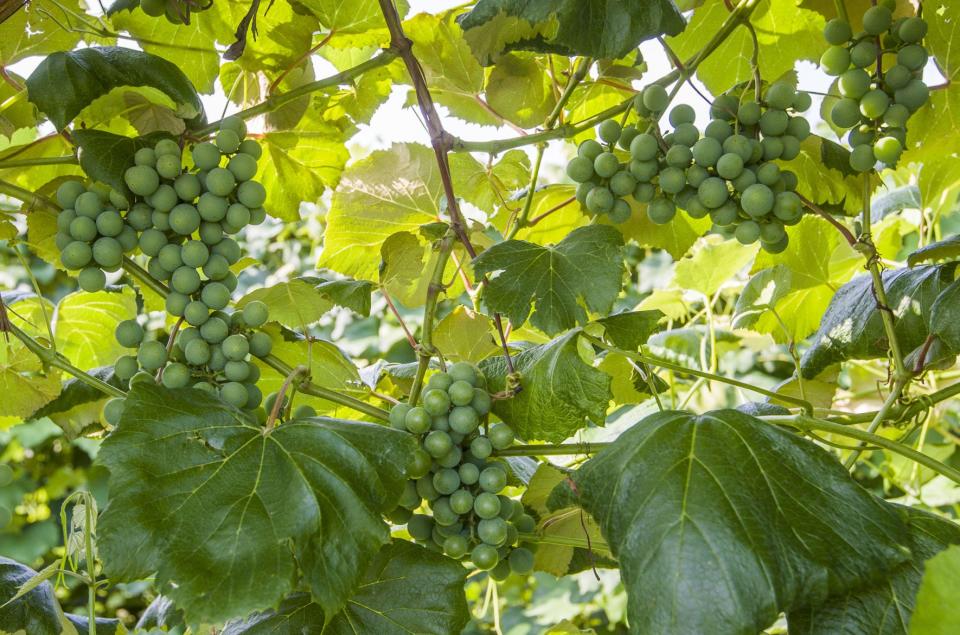Invasive and destructive: Spotted lanternflies are advancing to the fruit trees and grapes of Michiana
The highly invasive lanternfly has already been spotted in two Indiana counties and in one county in eastern Michigan, so bug experts know it’s just a matter of time before the sap-sucking insect shows up in Michiana.
Agencies in both states have worked to spread the word about the plant hoppers that were first found in Pennsylvania in 2014 and have now spread to about a dozen states east of here because they can cause significant damage to a wide variety of crops and plants.
Native to China, the bug likely arrived in the United States via imported cargo from Asia, according to the U.S. Department of Agriculture. And though it prefers to feed on the invasive tree of heaven, it also can severely damage grapes, apples, hops, walnuts and hardwood trees by sucking sap from branches, stems and vines.
Farm and Food:From Catalonia to California, it’s been one long, hot summer
If left unchecked, a 2019 study by Penn State University estimated the bugs could cause $324 million in annual damage to Pennsylvania alone. But the good news is that states, which experienced earlier infestations, have learned that lanternflies can be controlled with normal agricultural insecticides, said Michael Reinke, a Michigan State University extension pest management educator.
“We’re in a different world than we were five years ago,” Reinke said. “We now have a lot more tools that we know work. We’ve been ready for this and have been preparing for it for several years.”
In southwestern Michigan, owners of vineyards and orchards might have to add one additional spray each year or adjust the timing of their spraying in order to keep the destructive insects at bay, Reinke said.

In Indiana, the lanternfly was first detected last summer in Switzerland County in southeastern Indiana. In July, they were found in Huntington County near Fort Wayne, according to a release from Purdue University.
Cliff Sadof, a professor of entomology and Purdue Extension fellow, said the migration poses a significant agricultural risk to wine grape growers and walnut tree producers. Although the spotted lanternfly feeds on more than 100 different types of plants, Sadof said, the insect can reproduce only when feeding on walnut trees, grape vines or the tree of heaven.
In addition, Purdue warned that beekeepers need to be on the lookout for the pests because bees will make use of the honeydew secreted by the lanternflies and that can taint the honey, giving it a darker color and less desirable taste.
In Michigan, lanternflies were found in Oakland County in early August, and officials are now scouting truck stops, camp sites, distribution centers and other places where the hitch-hiking insects also might appear, Reinke said.
In 2019:Spotted lanternfly, a new invasive pest, aims to consume our grapes, hops and fruit trees
If people are traveling from eastern states, experts say they should be on the lookout for bugs that might be on their vehicles, RVs or camping gear as well as egg masses that are about an inch long and resemble a splash of light gray or tan mud.
“If you see them in the area, take pictures and report it to the state,” Reinke said. “Better yet, try to trap a live specimen because there are some look-alike insects.”
Besides insecticides, entomologists also are working on attractants that could be used to trap lanternflies, but so far, those efforts have proved unsuccessful, said Reinke, an entomologist.
In Michigan, the wine and fruit industries mean hundreds of millions of dollars each year for the state economy, Reinke said. And though insecticides are available, additional pesticide applications will add costs for growers, and an infestation could add significant costs because strict measures would be imposed to control the further advance of the insects.
Ultimately, Reinke believes farmers won’t be alone in combatting the insects because they'll eventually migrate to more urban areas, especially if there are tree of heaven and other plants to support them.
“Like most other pests, once they’re here, they’re going to stay,” he said. “We can control and manage, but likely not eradicate.”
Be vigilant:West Nile Virus detected in St. Joseph and Elkhart counties
The Indiana Department of Natural Resources is asking residents to search for and report spotted lanternfly sightings. Anyone spotting the insect should photograph it and send the image and location to DEPP@dnr.in.gov, or call 1-866-No-Exotic.
Those spotting a lanternfly in Michigan should call an Extension office or use the Eyes in the Field online reporting form. Learn more about the invasive insect at either Michigan or Indiana’s sites devoted to the insect.
Email Ed Semmler at esemmler@sbtinfo.com.
This article originally appeared on South Bend Tribune: Invasive and destructive: Spotted lanternflies advancing toward Michiana

